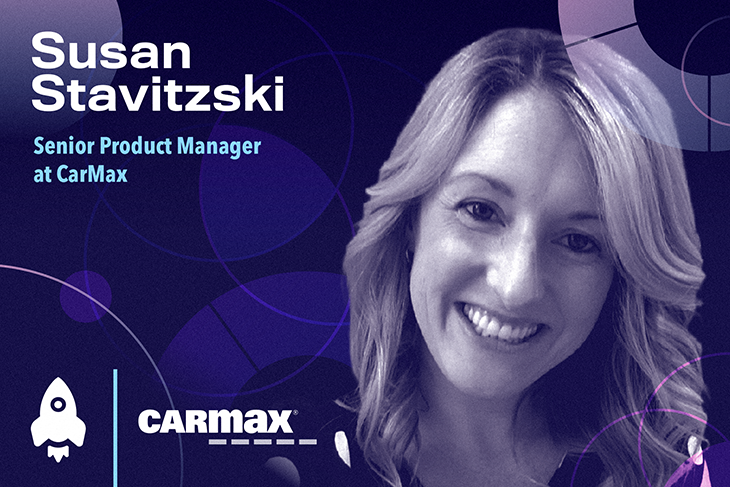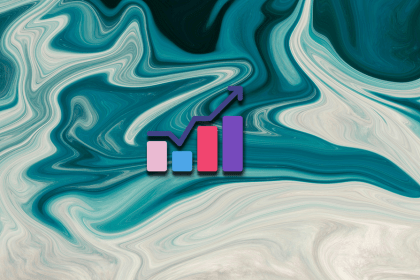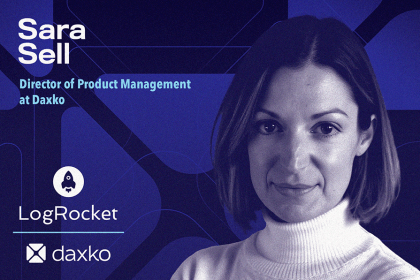Susan Stavitzski is a senior product manager at CarMax. She has been in her role for almost three years and was previously the director of product at Hatch, a small software startup.

Susan’s career didn’t follow a straight trajectory in product management, however — she originally started in marketing, where she developed an obsession with talking to customers.
We recently spoke with Susan to learn more about her background and how she found her calling for product management. We talked about the lessons learned she’s brought to CarMax and how CarMax does product management differently from the other organizations she’s worked for.
I am a senior product manager at CarMax. I’ve been working in product for almost a decade but started my career in marketing.
I was an event planner at a tech company for the first couple of years. That actually set me up for success because I was building in-person experiences, thinking about my customers and what they care about. Afterward, I worked at Snagajob, an online platform for hourly workers, and that’s really where I got exposed to what a product team was.
When sales at Snagajob got their feedback from customers, I was very curious about what they were going to do with it. They said, “Well, we give it to our product teams and they go build cool stuff.” And I thought, “Wow, I want that job!” I didn’t know that there was a job like that.
I made a plan on how I was going to transition from marketing to product. I talked with my manager and the company needed a strong marketer for their first ecommerce product team, so I moved to product marketing.
After that, I got to start my first associate product manager role. Though it was super intimidating, I applied anyway because I knew I wanted to make my way into product.
This was a very interesting role because the company had an idea but they weren’t sure if there was any business value. That was my task — to uncover what opportunities existed. I didn’t have a team. It was just me and a part-time designer helping me create wireframes and prototypes for user feedback. For a good two months, that was my job. But that created my foundation. Talking to as many people as possible is what made me a very customer-obsessed product manager.
I was incredibly fortunate to work in product at Snagajob when I did. Our leadership brought in amazing trainers like Jeff Patton and Teresa Torres to work directly with our product teams and engrain amazing product practices that I still use on my teams today.
Dual-track discovery and delivery, continuous discovery, best practices for customer interviews — these are all core skills that a PM needs and I was able to learn from some of the best. Christian Idioti, who’s now at the Silicon Valley Product Group, was a product manager at Snagajab when I worked there. I got to see him bring a brand-new product to market.
I’m so grateful that Snagajob invested in the teams we had at the time. I try to educate new PMs that I work with on those who haven’t had that direct exposure. But I’ve also done a lot of failing. I’ve done plenty of customer calls that have fallen completely flat. I stumbled over my words, didn’t get good insights, or didn’t do the best planning.
I try to tell people who are getting into customer discovery or are nervous about it — just do it. It’s never going to be perfect, but the next time will be a little bit easier. To a point where you’re excited to talk to customers and show them something. It just takes time. No one’s good when you first start. You have to do it over time and you’ll figure out the right rhythm.
There’s a pattern I like to follow for getting ready for customer calls. First, what are we trying to learn? I work with my design partner to build a learning agenda so we have a game plan ahead of the call. We start with why we’re having the call and then outline the specific questions we hope to cover. It’s good to have go-to questions so it doesn’t get awkward. This prep doesn’t take a lot of time and helps with the alignment between the PM and designer.
I love getting on calls because I feel like they’re very good relationship builders. Take yourself out of the equation and try to put yourself in customers’ shoes. Talking to customers as often as possible is one of my favorite parts of the job.
Until coming to CarMax, I didn’t know what a fully-staffed team even meant. In my past experience, the PM was also the marketer, the analyst, the delivery manager — those are just hats that a PM wears.
CarMax really embraces the idea that you need fully-staffed teams to get the most out of your work and feel supported. I have a delivery manager and an analyst. Never had those before! I’m like, “Wow, that used to be my job.” It’s amazing having those dedicated roles. Of course, we have developers and a dedicated designer on our team, which is fantastic.
At CarMax, we have something really unique to us — a principal field lead. For most PMs, getting time with the customer is a huge reason why we do research. However, it takes a lot of time to set up.
CarMax recognizes that and puts a principal field lead on product teams to say, “Hey this person has field experience. They’ve worked in our stores or in one of our departments and now they’re bringing all that expertise to the product team.” If you need to get in front of customers, they help with scheduling, setting up calls, and setting up visits to the store. I would say that’s been one of the biggest supports of a PM.
I have more time to focus on the vision, strategy, and priorities of the team. Are we running after the right things? Did we appropriately validate this? Do we understand the customer and the problem, and see how our work fits into the overall company roadmap?
With such a huge platform that CarMax owns and the industry that we’re in, there are a lot of product teams taking each individual piece. We want to make sure that to the customer, it is one seamless experience. PMs have to stay tight on building separate pieces that feel like one cohesive experience. We’re spending time together making sure we’re building that seamless experience.
Our leadership believes in empowered product teams. We have people with product experience in leadership positions. We also have very strategic leaders. They understand that building a strong strategy doesn’t just mean product strategy — it’s how we’re setting up our team to drive towards the outcomes we want to deliver as a company.
I would say the least successful calls are when customers don’t want to talk to you.
I think a lot of people go, “Oh, I want to talk to customers who want to share feedback with me.” Yes, that’s true, but those aren’t all of your customers. You’re going to have very loud customers who want to tell you all the great things. But you’re also going to have very angry customers and quiet ones who don’t give any feedback. You need to understand all three groups, otherwise, you’re losing significant segments of people who use your product.
When I worked at the startup, I told our customer support team, “If anybody is mean to you or yelling at you about the product, send them to me. I want to talk to every single one of them.”
Usually, it’s because they just want to be heard. After five minutes into the call of just listening, they’re calm. If you include them in trying to build a solution, you’re going to have a customer for life. So it’s really easy to deescalate that if you just provide the time.
Having a list of questions or things that you can show them helps. I would say those are my fumble moments of not being prepared — not having something ready to shift the room or shift the vibe.
It’s a few different flavors. It depends on what your problem space is and who your customer is.
CarMax is a marketplace — we buy and sell cars. Some of our customers do the buying or selling. We have partners that work with CarMax and we run an auction business as well. We also build products for our store associates. All of these may warrant different ways of doing discovery.
Most of our teams try to get in front of customers as often as possible, whether it’s a 1:1 meeting or focus group. We try to talk to at least one customer a week. We can get a handful of associates on a call every week too. I personally work for a team that builds associate-facing tools, so we go into stores to shadow them and live the experience. When we’re building technology, we’ve sat next to them, watched them push the buttons, and seen their frustrations.
When I first got in at CarMax, I went to a store and was following an associate doing an appraisal on a vehicle. We have a process for checking the car where an associate reviews the car and takes pictures of it, etc. So I’m following the associate throughout the entire flow, and at one point, they whip out a piece of paper. They say, “We have to write down this data to put it into this other system.” I ask why, and they say, “I don’t know. We just always did it that way.”
Everything is tech except for this piece of paper. I got back to the office and asked about it. My colleague says, “Oh, they’ve just always done it that way.”
It was nowhere near my job or space, but I pulled on the thread. I eventually found the team who owns this part of the journey and they said, “They’re still using the paper? We fixed that!!” We had already solved this problem to get rid of the paper, but the associates hadn’t made the connection. It was great to let them know that. We followed up and were like, “Hey, just a reminder, you don’t need the paper anymore!”
You have to always remember that when you’re building products, you’re not just releasing the code. Your job is not done. You have to ensure the customers adopt it and understand how to use it. Look at the analytics to make sure it’s doing what you wanted it to do.
Oh, yeah, definitely. I mean, even at a startup you’re going to be doing manual processes to get off the ground. Over time, you’re like, oh, we should really get rid of that spreadsheet. We should really get rid of that spreadsheet. And then that spreadsheet is still around 10 years later. And you’re wondering, why haven’t we gotten rid of that spreadsheet?
LogRocket identifies friction points in the user experience so you can make informed decisions about product and design changes that must happen to hit your goals.
With LogRocket, you can understand the scope of the issues affecting your product and prioritize the changes that need to be made. LogRocket simplifies workflows by allowing Engineering, Product, UX, and Design teams to work from the same data as you, eliminating any confusion about what needs to be done.
Get your teams on the same page — try LogRocket today.
Want to get sent new PM Leadership Spotlights when they come out?

Understanding your margin of error and confidence intervals helps you make solid product decisions and avoid costly mistakes.

By implementing an effective PDM system, you can foster collaboration, improve decision-making, and accelerate your time-to-market.

Sara Sell, Director of Product Management at Daxko, shares how she developed skepticism and curiosity from her time in teaching and research.

A well-defined customer discovery process serves as the foundation for building products that customers truly want.